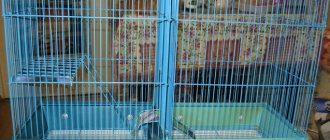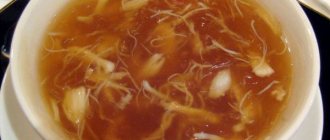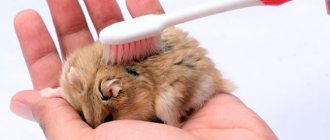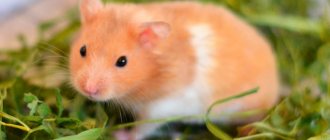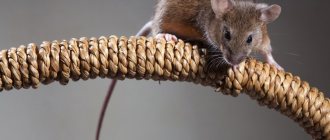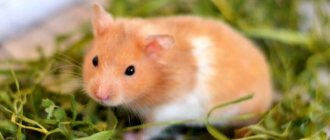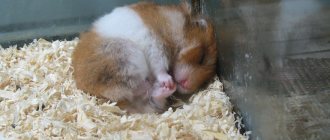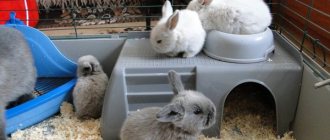Chinchillas are popular pets from the rodent family with an attractive appearance and funny character. They are easy to care for, clean and do not require constant attention. But there are still some rules for keeping pet chinchillas that a novice owner should familiarize himself with in advance.
In the article we will tell you how to keep a chinchilla at home, what conditions need to be created, what is the life expectancy of the rodent, character traits and behavior, choice of cage and its arrangement, diet, how to tame and walk your pet, is it possible to bathe, breeding, what diseases do you have? chinchillas, advantages and disadvantages of keeping them.
Features of chinchillas
Chinchillas are medium-sized rodents with beautiful thick fur and a bushy tail. The coat color is gray with a white belly. There are also representatives of black, snow-white, white-pink and beige colors.
The maximum weight of an adult chinchilla is 800-900 g, and the height of the animal can reach 30-38 cm. The length of the tail is 12-17 cm.
Chinchillas have large, slightly rounded ears, by which you can always determine your pet’s mood. If he is scared, the ears lie on his back, in the same position they are when the animal sleeps. And if the chinchilla listens and shows interest, its ears rise high.
These exotic rodents have very beautiful shiny black eyes in which you can see your reflection. Chinchillas also have strong and massive hind legs, which allow them to easily push off the ground when running. They are longer than the front legs.
Character, behavior and habits of a rodent
Chinchillas are smart animals that adapt well to home conditions. They are very inquisitive, show interest in the world around them and do not ignore any changes in the cage or room. If guests appear in the house, they react very violently, trying to attract attention to their person. They also make interesting sounds, by which you can understand how the animal feels. For example, if a chinchilla is unhappy with something, it makes a cracking sound.
Other behavioral features, habits and character of the chinchilla:
- very energetic, can jump vigorously in the cage, demanding release;
- are nocturnal, sleeping most of the day;
- quickly become attached to the owner, but do not like affection, prefer to be watched from the side;
- They tolerate loneliness well.
A distinctive feature of chinchillas is also their cleanliness. They always keep their fur clean and never stink. The owner needs to support this habit of the animal and regularly clean the cage.
Chinchilla and child: is it worth buying a rodent for children?
Many people believe that a chinchilla is ideal as a pet for a small child. They rely on ease of cleaning and the friendly nature of the rodent. However, experts say the opposite. They advise getting such an animal when the child reaches 10 years of age. There are reasons why it is not recommended to keep a chinchilla in an apartment where children live:
- The chinchilla is a nocturnal animal, so the child will be bored watching the rodent during the day. At this time, there is a decline in activity, and the pet usually sleeps;
- Noisy children can traumatize the animal's psyche. The animal will be in a depressed state;
- Chinchillas do not like to be picked up and dragged around. A small child can injure a pet by squeezing its body tightly;
- You cannot feed the rodent food from the table. The child may not know this and give it a flour product. This can disrupt the animal's gastrointestinal tract. Sometimes digestive problems can cause death;
- If you do not supervise the child, he may open the cage door. The animal will run away and hide in a place from which it will be difficult to get it.
Rules for keeping chinchillas at home
Caring for chinchillas at home does not pose any particular difficulties, but it requires proper equipment of the cage where the exotic rodent will live and compliance with the temperature regime.
What kind of cage is needed and how to arrange it
The ideal home for a pet chinchilla would be a spacious cage measuring 60x50x100 cm. The fluffy rodent loves to jump around the cage, so the higher it is, the more comfortable the pet will feel.
After purchasing a suitable cage for a chinchilla, we move on to its proper arrangement.
Required equipment:
- Feeder and drinker for food and water. It is advisable to purchase metal dishes so that your pet does not chew them. It is also necessary to securely fix the feeder, as rodents love to carry them in their teeth.
- Chalk stone for grinding teeth (sold in pet stores).
- Toys – wooden cubes, walnut shells.
- Active rodents will love a running wheel, but a regular one will not work as it has too large distances between the bars. An alternative option would be a metal wheel. In place of the rods there is a mesh. During running activities, a chinchilla can injure its paw. For such rodents, special solid wooden wheels are provided, which are safe for active jogging.
- You can also place large, non-sharp stones, tree branches, and ladders in the cage. In hot weather, the chinchilla will be able to cool off on the branches. This will help her avoid overheating, which is detrimental to her. It is very important to choose durable accessories and securely fasten them in the animal’s home so that during active movement they do not fall and injure the chinchilla.
- For entertainment complexes, wooden bridges, tunnels and even hammocks made of thick fabric are installed in the cages.
- Chinchillas love to take sand baths. At least once every 2-3 days, a bathing suit with clean volcanic sand, selected according to the size of the animal, is installed in the cage. Sand must be purchased at a pet store. You can leave the bathing suit inside the house for about 30 minutes, and then it’s better to remove it, since chinchillas can urinate on the sand. In this case, an unpleasant odor appears in the cage. Prolonged contact with sand is contraindicated; it dries out your pet's skin.
In pet supply stores you can buy everything you need to equip a cage with a pet chinchilla. The assortment includes a wide variety of toys for the inquisitive rodent. Products made from natural wood are considered the safest. Over time, the chinchilla can chew them off, but such toys bring a lot of joyful emotions to the animal and allow them to have fun without the attention of the owner.
Comfortable temperature for a chinchilla
A prerequisite for keeping a pet chinchilla is the creation of a favorable microclimate with maintenance of optimal air temperature. These animals feel comfortable at a temperature of +12+230C. Direct sunlight should not enter the cage, as it is harmful to the rodent. The optimal humidity level is no more than 60%.
When the air temperature is higher than the maximum recommended value, chinchillas feel unwell and become inactive. They experience similar discomfort at low temperatures. You can control the temperature in your pet chinchilla’s home using a regular room thermometer and a hygrometer, which determines the level of humidity in the room.
Items and accessories for cage equipment
A properly equipped home will make the animal’s life convenient and comfortable. The vital attributes of caring for a domestic chinchilla include a feeder, a drinking bowl, a haybox, a house in the absence of shelves, a bathing area and a mineral/salt stone for grinding down teeth. If litter is not used as a toilet, then a special tray is purchased. Hanging ladders, labyrinths, tunnels and a running wheel are optional accessories. If the cage size is small, it is better to use a hammock as a place to rest.
Caring for a chinchilla at home
Chinchillas living at home need the owner's care and proper care.
Main responsibilities of the owner:
- organizing proper and timely nutrition for the rodent;
- hygienic care of animals;
- cleaning the cage.
What and how many times a day to feed
Proper nutrition is the key to the health and long life of a rodent at home. 70-80% of a domestic chinchilla’s diet consists of ready-made food made from pressed grass pellets. This product is purchased at pet stores. When choosing food, study its composition. It should not contain additional additives, preservatives, yeast or salt.
The recommended daily portion of ready-made food for chinchillas is 2 tbsp. l. Uneaten remains are removed from the feeder, and the next time fresh food is given.
Additional bait to the chinchilla's main diet:
- Cereals. Every day you can feed your chinchilla a cereal mixture of corn, rolled oats, buckwheat, lentils and flax seeds. The dosage of each ingredient is 1 tsp, and flax seeds - no more than 1/3 tsp.
- The hay is clean, purchased, without any pungent odor, roots or soil. This product is given once every 3-4 days in small portions.
- Treats (no more than 10% of the diet). You can pamper your pet with ready-made bait from stores, as well as dried berries, fruits and branches of healthy trees.
Chinchillas can be given twigs and leaves of viburnum, acacia, maple, cranberry, hawthorn, rowan, gooseberry, sea buckthorn, Jerusalem artichoke root, calendula and jasmine flowers, leaves of lemon balm, mallow, oregano, alfalfa and nettle.
Allowed products also include grape leaves, stems of chamomile, clover, mint, thyme, string, coltsfoot, apple inflorescences and fruits, willow buds, pumpkin seeds, parsley, sweet peppers, carrots, strawberries, raspberries, blackberries, honeysuckle and lingonberries.
Allowed treats are given in small portions. It is advisable to treat your pet with a variety of baits so that his body receives all the necessary microelements.
Important rules:
- herbs and twigs for feeding chinchillas are collected in ecologically clean areas far from highways;
- be careful when choosing foods to feed your chinchilla and never give the animal spoiled or dirty food;
- A chinchilla should not be overfed with sweets, since the liver of this rodent is not designed to process large amounts of glucose.
Remember: a harmful and unbalanced diet provokes various diseases and leads to the premature death of a pet.
Bathing and grooming chinchillas
Chinchillas are clean animals that take care of their luxurious fur on their own. The owner can only take a small part in caring for the pet, providing her with the opportunity to take pleasant and healthy sand baths by placing a container with sand in the cage.
It is not recommended to bathe your chinchilla in water. Water procedures can result in inflammatory diseases. These rodents are very vulnerable to hypothermia and catch cold quickly. If the fur is heavily soiled, you can moisten a soft cloth with water and gently wipe your pet’s fluffy coat.
Chinchillas do not need nail trimming or ear care. They cope with these hygiene procedures on their own. The owner only needs to monitor the oral health of the furry pet. A stone for sharpening teeth, as well as branches of useful plants, should be constantly available in the cage.
Cleaning the cage
Once every 3-4 days you need to clean the chinchilla’s cage. It is recommended to fill the bottom of the structure with special fillers. They absorb moisture and unpleasant odors well and are absolutely safe for rodents.
How to clean:
- The bottom of the cage is cleared of debris and other contaminants. For convenience, it is recommended to use a small brush and dustpan.
- The surfaces of the structure and accessories are cleaned of dust with a damp cloth.
- Once a month it is recommended to disinfect the cage and internal elements. This procedure is carried out in order to destroy pathogenic microorganisms, which will eliminate the risk of illness for the pet.
- Every day you need to change the water in the drinking bowl and keep the feeder clean.
Cleaning the cage will not take much time and will provide safe living conditions for your furry rodent at home.
Setting up an animal cage
You can buy a house for a chinchilla at a pet store or make it yourself from wood. It is important that the pet has enough free space, the ability to climb up/down, and rest quietly in a secluded hole. It is advisable to take a cage up to 100 cm high with several levels.
According to the standard, an animal cage must contain the following things:
- house for sleeping and relaxing;
- devices for jumping and running;
- salt or mineral stone for sharpening teeth;
- bath for bathing;
- litter tray with filler;
- feeder and drinking bowl.
Many breeders put tree branches in the cage. In spacious houses it is useful to install pipes in which rodents like to hide. They also love to spin the big wooden ring. Additional accessories include labyrinths, toys, hanging hammocks and ladders.
It is advisable to change the bedding in the cage every 3-4 days. Special mixtures are sold for rodents, but you cannot put pieces of paper, fabric, or sawdust into the animal’s house. These items can poison the chinchilla, injure the pet's body, cause irritation or allergies.
A chinchilla cage should have strong and strong bars that the animal cannot chew through. Breeders prefer metal options over plastic or wood. These are standard cages or display houses.
Flexible animals can squeeze between the bars, so the distance between them should be minimal - 1.5-2 cm. Internal and external objects in the cage should not be coated with varnish or paint.
Near a metal cage with bars there will always be dirt in the form of food debris or bedding. Glass display cases with a wooden frame and metal mesh are more practical and muffle noise from your pet. But over time, wood absorbs unpleasant odors, begins to crack, and swells from moisture.
Wooden display cages are more difficult to clean than iron display cages. It is better not to clutter a small cage with unnecessary accessories. The animal should move normally around its home, and not endure inconvenience and trip over strange objects.
You may be interested in: Yorkshire Terrier (York) description and character of the breed
Cell walls, trays, and rods cannot be cleaned with household chemicals. Once a month, you need to thoroughly clean the cage with plain water. All wood filler is removed.
Taming and walking
Chinchillas are self-sufficient animals by nature, preferring solitude. They cannot be raised and tamed like dogs or cats, although there are exceptions. Some furry representatives show affection and happily sit in the arms of the owner.
How to tame a pet chinchilla:
- During the first days of a week of living in a new home, the rodent needs to adapt. During this period it is better to leave him alone.
- Starting from the 3rd week, you can begin taming: talk to your pet, try to open the cage and extend your hand to the chinchilla. This may interest her, she will begin to sniff the palm and quietly bite the fingers. Chinchilla bites are absolutely safe and painless.
- When the chinchilla gets used to the owner's hand, it can jump onto the palm. The owner does not need to make sudden movements and try to pull the pet out of the cage. At first, such communication procedures are enough.
- For any success in training, you can reward your chinchilla with a tasty treat.
- When the rodent gets used to the person, you can try to lure him out of the cage and put him in your arms. Prepare a treat for your furry friend in advance. Gently stroke the fur on the neck, ears and chest, encouraging the animal with kind words. Try not to stroke your chinchilla's back or sides; he won't like it.
- Communicate with the chinchilla, calling it by name, let it get used to its nickname.
- Do not pick up your chinchilla against its will. She may get scared and bite or scratch in self-defense. Another fighting technique of this rodent is shooting urine at the enemy.
If a chinchilla finds contact with its owner unpleasant, it will make a dissatisfied noise. At such moments, it is better to leave the rodent alone and postpone all attempts to tame the pet to another time. Let her calm down and get used to attention from people.
How to play with your pet
Pet chinchillas are afraid of sharp sounds, so you need to move as quietly as possible in their presence. At first, the animal needs to get used to the new environment and smells. You should pick it up gradually so as not to scare it. You cannot force an animal out of its cage. When the pet gets used to it and begins to trust its owner, you can start playing with it. To do this, it is recommended to use various toys:
- Products made from natural materials. Wooden toys allow the animal to sharpen its claws and teeth. Instead of store-bought ones, you can use simple branches from hardwood trees.
- Labyrinths and tunnels are in great demand among rodent owners. You can make them yourself using plastic or wood.
- For animals that are very active, a running wheel is suitable. A chinchilla can spend several hours in it. Stairs can also be used as a running machine. They are installed in the display case in the openings of the shelves. Often the pet scratches its back on them.
Possible diseases
For a number of reasons, your pet chinchilla can get sick. In such cases, the pet will require immediate medical attention. An experienced specialist will conduct a diagnosis and select a treatment course based on special medications intended for rodents.
What diseases can a chinchilla develop:
- Hyperthermia is overheating of the body. This condition occurs if the recommended temperature regime is not observed. The deterioration of the pet’s condition begins already at an ambient temperature of +250C. If the air warms up to 300C, the chinchilla may die suddenly. The main symptoms of hyperthermia: immobility, redness of the tongue, stretching of the body while lying on its side, convulsions. First aid: the cage with the chinchilla needs to be moved to a cool place. To relieve her condition, it is recommended to moisten the outside of her ears and paw pads with cool water. To prevent dehydration, give your chinchilla water to drink.
- Abnormal stools and liquid feces are a fairly common problem in domestic chinchillas that arise as a result of poor quality nutrition or after a change in food. The owner needs to disinfect the cage and review the chinchilla’s diet. To combat loose stools, special medications are used that can be purchased at a veterinary pharmacy.
- Colds - occur due to hypothermia of the animal. For example, if the cage is in a draft or the chinchilla has been in low temperatures for a long time. Main symptoms: runny nose, cough, sneezing, watery eyes, lethargy. Chinchilla colds can be treated with medications prescribed by a veterinarian.
- Ringworm is manifested by hair loss in a certain area of the body. It develops as a result of stress or fear, as well as due to low immunity, unsanitary living conditions, or after contact with an infected pet. It is treated with special ointments as prescribed by a doctor.
In addition to the listed pathologies, the domestic chinchilla can develop diseases of the eyes, ears, digestive organs, reproductive system, and even have a stroke. Proper care and quality nutrition will reduce the risk of developing diseases.
Proper pet nutrition
A balanced, proper diet is the key to an active, happy and long life for a chinchilla (6-7 years). Some individuals reach up to 10 years of age. The animal must be fed the same food that it obtains in the wild. Regular pet stores sell many granular and grain mixtures designed specifically for feeding our furry rodents.
It includes not only a variety of cereals, but also pieces of dried fruit, seeds, and dried healthy herbs. More expensive foods are enriched with alfalfa and echinacea to support immunity, vegetable oils, vitamins and minerals.
In addition to the main food, there should always be fresh hay in the pet's cage to improve digestion. As treats, chinchillas are offered dried or fresh leaves of green lettuce, clover, sea buckthorn, spinach, plantain, nettle, and dandelion. Sometimes the animal is allowed to give a piece of dried carrot, apple, nut or raisin. A branch of birch, willow, linden, or apple tree is suitable for sharpening teeth.
The most dangerous thing is to feed your animal fresh fruits and vegetables, bread and other flour products, sweets, fatty pine nuts and almonds.
A chinchilla can become bored with a monotonous diet of dry food, so you need to purchase a new mixture every 4-5 months. Food should be available both day and night, as should clean water. In a year, a middle-aged chinchilla eats up to 6 kg of hay and 10 kg of combined food. It is better to collect and prepare hay yourself; it should not be wet, moldy, or with clods of earth. It should not contain poisonous herbs such as ferns, horsetails and buttercups.
It is advisable to include salt slime and chalk stone enriched with minerals in the menu. Feed is poured into the feeder once a day. This is enough to satisfy the animal. Some breeders introduce their own mixture of small lentils, corn, rolled oats and buckwheat into the animal’s diet. Additionally, flaxseed, enriched with healthy fatty acids, is added to the food.
As useful supplements, veterinarians recommend giving mallow leaves, willow leaves with buds, branches of hazel, aspen, poplar, several fresh viburnum berries, strawberries, raspberries, lingonberries, Jerusalem artichoke root or parsley. The animal will certainly appreciate pumpkin seeds, raw peanuts, as well as fresh leaves of good green tea.
Chinchilla as a pet: pros and cons
Keeping chinchillas at home has its pros and cons. Let's look at them.
Pros:
- An independent and clean rodent that does not require constant attention, it is an excellent choice for busy people who do not have the opportunity to devote a lot of time to their pet.
- A chinchilla does not produce an unpleasant odor, even if the animal’s cage has not been cleaned for several days. This is due to the absence of sweat and sebaceous glands in the rodent’s body.
- Chinchilla fur does not harbor fleas and ticks.
- Chinchilla fur is hypoallergenic.
- These animals carry out hygienic care on their own, which reduces the list of responsibilities for the owner.
- They have strong immunity and do not suffer from genetic diseases.
- They eat little, so you don’t have to spend a lot of money on food and necessary accessories for your chinchilla.
Minuses:
- are nocturnal;
- afraid of loud sounds;
- can't stand heat;
- walks around the house can only be done under supervision, as a chinchilla can chew furniture and other interior items;
- To keep a rodent, you need a spacious cage with good equipment so that the self-sufficient and active animal always has something to do.
Chinchillas are cute, fluffy animals with interesting behavior patterns that bring their owners a lot of positive emotions.
Why can't a chinchilla walk around the apartment?
The apartment is not intended to contain a chinchilla. Sharp corners of furniture, vases of flowers and sockets can pose a danger to your pet's life. If an animal chews on electrical wires, it may receive an electric shock. Even if all possible problem situations are provided for, leaving the cage is undesirable for the animal. Leaving your home can be stressful, causing your pet to develop a fever. Temperature changes negatively affect the health of the rodent. Possible heatstroke or stroke. To prevent the animal from having to leave the cage, the owner should take care of organizing a special place for an active lifestyle inside the home.
How to choose the right chinchilla when buying?
To avoid the hassle of caring for an unhealthy animal, you should carefully consider the choice of animal.
- The first thing the future owner should do is pay attention to the appearance of the pet. A healthy animal will have beautiful, smooth, tangle-free fur. The eyes will sparkle.
- The animal's breathing should be clear, without wheezing or whistling.
- The eyes should be clean and free of discharge. Particular attention should be paid to both eyes; if they are inflamed, then the animal has some kind of infection.
- When coming into contact with a chinchilla, it is recommended to inspect and lightly palpate the muscles. Weak muscles, protruding ribs, lack of fur in some places, or too much fat are signs of improper care of the animal or disease.
- A sign of illness or poor diet is matted fur in the anus, which indicates the presence of indigestion.
- When purchasing a chinchilla for breeding, you must purchase a pair at once.
- If the animal is purchased alone, then due to the pet’s discomfort due to loneliness, the owner will have to devote much more time to it than originally planned.

